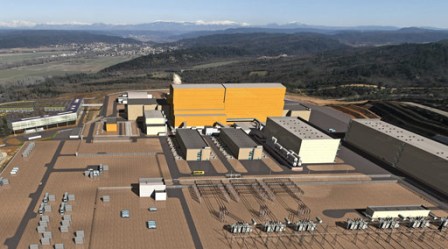A flurry of contracts has been awarded by Iter's European domestic agency, Fusion for Energy (F4E) that will see the next generation international fusion facility really begin to take shape.
 |
| How the completed Iter building could appear (Image: Iter) |
The biggest of these is the €230 million ($305 million) principal civil engineering contract that was awarded to a consortium of Vinci, Razel Bec and Ferrovial Agroman which covers the design and construction of 11 buildings and storage areas at the site. Included in these is the Tokamak Complex that will eventually host the magnetic fusion reactor, as well as the assembly hall in which it will be built. Works are expected to run through to 2018.
Another contract, this time in the range of €35 million ($46 million) has been awarded to Cosma Emte for general site infrastructure works. They are to supply a drainage system, outdoor lighting, car parks and roads as well as the facility's water management system. Work is expected to take five years.
And for the reactor
F4E announced on 5 December that a €160 million ($212 million) contract for the supply of 70 radial plates had been awarded to a consortium of Simic and Constructions Industrielles de la Mediterranee (CNIM). The plates form part of the large D-shaped toroidal field magnets which will keep the hot plasma confined.
Diagnostic components for Iter's plasma position reflectometry will be provided under a €3.5 million ($4.6 million) Framework Partnership Agreement by a consortium of three Euroatom associations: Instituto Superior Técnico (IST) from Portugal; Centro de Investigaciones Energéticas, Medioambientales y Tecnológicas (CIEMAT) from Spain; and Italy's Consiglio Nazionale delle Ricerche, Istituto di Fisica del Plasma "Piero Caldirola" (IFP-CNR). They are to design a combination of antennas, wave guides, microwave electronics and software which will monitor the density of the plasma edge - important for preventing disruptions.
Finally, the task of manufacturing prototype semi-scale first wall panels has been awarded to a consortium consisting of Iberdrola Ingeniería y Construcción S.A.U., AMEC Nuclear UK Ltd and Mecánica Industrial Buelna, S.L. This is the first cautious step in a process that will eventually lead to Iter's first wall, which must serve to protect the reactor's vulnerable components from high energy neutrons and any escaping plasma. A contract for the manufacture of full-scale prototype panels should be launched next year.
Iter is the great hope for fusion energy research - a tokamak device that aims to produce 500 MWt for sustained bursts of seven minutes and which will hopefully pave the way for a future demonstration plant. It is being constructed in Cadarache, France. The project is a massive endeavour of international collaboration, coordinated by domestic agencies representing Europe, the USA, China, South Korea, India, Russia and Japan.
Researched and written
by World Nuclear News






_53514_33880.jpg)






